The Vegan RD says we need at least three servings of legumes and soy foods per day. When I’m eating well, I cook a pot of beans nearly every day. Even though I’m a lazy cook I nearly always cook fresh (or rather dry beans) rather than using canned for three main reasons:
- They’re cheap
- They aren’t high in sodium
- Most importantly, I don’t like the taste of canned beans!
Because I live at 9000ft/2700m elevation I pretty much have to use a pressure cooker for cooking dry beans. I think it’s a good method at any elevation. That said, don’t use my cooking times, I generally double the recommended cooking times compared to someone at sea level. My pressure cooker instruction booklet has guidelines for adjusting for elevation. If you aren’t at sea level you might look for similar guidelines for your cooker.
It’s easiest, and best, to soak the beans overnight. When soaking dry beans there should be enough water in the bowl so the beans can at least double in volume. Some varieties will expand more than this. Your bowl should accommodate at least triple the volume of the dry beans (quadruple for Limas) so the beans aren’t all over your kitchen counter in the morning.
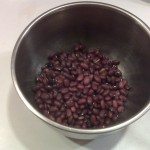
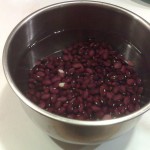
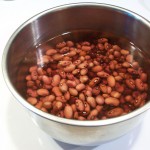
The quick way: For many reasons not as good as an overnight soak, but if you’re having a bean emergency, put beans and plenty of water in the pressure cooker. Bring up pressure, then turn off the heat and let the pressure come down using the natural release method. No, you cannot save time and cold-water release in this case.
Rinse the soaked or pre-cooked beans well. You should probably check for rocks/pebbles too, if you didn’t already. If you soaked overnight, any clumps of sand/dirt should have dissolved so they’ll rinse away.

Put the beans in the pressure cooker and cover with about twice as much water. Bring up the pressure and then turn the heat to low. Depending on your stove you may need to double-up grates so the pressure doesn’t continue to build. Cooking time will vary with the type of bean. Pintos, red, black, white, kidney all have a similar cook time. Garbanzo’s take longer. Most Limas cook very quickly and are easy to overcook. Check your pressure cooker manual.

After the prescribed cooking time, turn off the heat and let the pressure drop naturally. The beans will continue to cook during this time. When your cooker has depressurized, you can remove the lid, and you’ll have a nice pot of unseasoned beans.
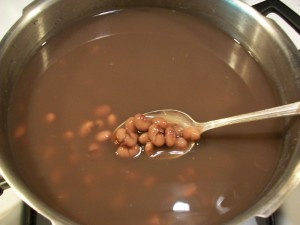
Lately, I’ve been simmering my beans most of the day and tweaking for each meal. If I’ve started early enough I may have a serving for breakfast. For this batch I added a little beer (wine is good too), a veggie bouillon cube, a little dry basil, onion, sweet pepper and 4-5 cherry tomatoes. This was lunch.
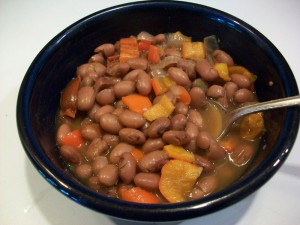
By dinnertime the flavors had really concentrated, and I needed more veggies for the day, so I added frozen broccoli and mixed veggies and simmered 10-15 min. Lunch was a little more soup like. This is basically a veggie, bean stew.
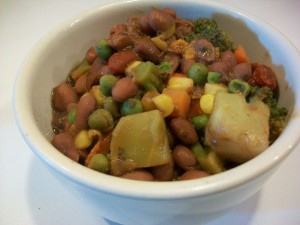
I usually don’t cook the same type of beans two days in a row. My regulars are pinto, northern white, red, kidney, black. Occasionally I’ll have Lima or garbanzo. I also vary the basic seasonings from day-to-day, with a rough pattern of beer/wine (if I have any I need to use up), veggie bullion and spices. Cumin, basil, oregano, tumeric, paprika, chili powder, thyme, rosemary, sage are some I use frequently. Not all together. I like to add some sort of flavorful vegetable if I have anything. Partially dried tomatoes, peppers (sweet or hot), onion are good choices. A good combo is beer and chipotle pepper, dried or from a can. Anyway, there are endless varieties. Try some of your favorite things. And, if you’re like me, you’ll never have exactly the same thing twice.

Great blog! I am a huge bean fan, but find they don’t cook very well just by boiling them, so I end up using canned.
I want to try a pressure cooker (I am at sea level right near Philadelphia, PA!). Do you have any recommendations for a particular make/model?
Thanks and happy MoFo!
That sounds similar to my situation before I got a pressure cooker. I could boil beans all day and they’d still not be tender. And I really don’t like partially cooked beans. Mine is Kuhn Rikon pressure cooker. I got it about 15 years ago in a set with 2L and 5L pots , one pressure lid, and one glass lid. I nearly always use the 2L, but the 5L is nice on the occasions that I need a bigger pot. I was going to do a more detailed post about it in the next few days.
Thanks, Cathy!! I’ll check Amazon to see what they’ve got in terms of pressure cookers…or I might just keep using canned! :-) I’ll look for your next post for more info!
Cathy, I took the plunge and got a pressure cooker and it rocks! Here’s my MoFo post from tonight, I made a black-eyed pea stew and it turned out great!
http://veganfazool.blogspot.com/2011/10/pressure-cooker-black-eyed-stew.html
Thanks for keeping me motivated!
XO
Dawn, that’s great! I enjoyed reading your post. It’s a yummy looking stew … except for the black-eyed peas. I must’ve had a bad experience with those at the school cafeteria when I was a kid. : )
I wonder what it was that put you off! Impressive that your school even ever served beans, though probably not a good thing for the poor beans! I don’t remember a single bean dish from all of my years at public school, except maybe baked beans? I don’t even think there were baked beans!
Well, if you ever want to try them, black-eyeds are very mild, if you ate one in a blind taste-test I’m sure you wouldn’t even know it! And because you don’t need to soak, they are even more convenient than the others. May be worth a shot. Just cook them in flavors you already like and then they taste like that :-)
I bet it was something it was cooked with that was nasty, like rancid bacon fat or something, or maybe they were canned and yucky.
<3
P.S. Do you make split peas in your cooker? Mine has this bold warning not to ever cook split peas (and some other things) in there…but I see recipes for split pea soup in a pressure cooker…??? Any ideas?
I haven’t made split green peas in my cooker in a long time. Split yellow peas more recently. I don’t recall any problems, but I don’t know if the altitude affects that. Because my cooking times are longer, but the pressure gauge rises the same, I’m guessing that the temp is lower at the same pressure. It’s possible that with the lower air pressure the pressure in the pot is a little lower also.
I’ve also seen warnings not to cook rice, but I always cook rice in my pressure cooker without any major problems.
With some things, particularly with the smaller pot filled near the max line, occasionally the broth bubbles up and the pressure indicator will stick. Easily fixed by manually unsticking it during cooking, and dissembling and cleaning afterwards. : )